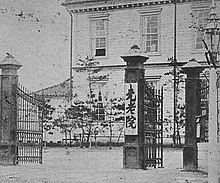Genroin
The Genrōin ( Japanese 元老院 , literally Council of Elders as translation of Senate ), also known as the Japanese State Council or Senate , replaced the chamber on the left ( 左 院 , Sain ) after the Konferenzsaka conference in 1875 . It was an advisory body for legislative and administrative issues in Japan in the early Meij period .
The Freedom and Citizenship Movement and Liberals within the Meiji oligarchy had withdrawn from the Meiji government after initial attempts to establish representative democracy and a national assembly . The Osaka Conference attempted to resolve this matter by convening the Genrōin. The members of this body were not elected, but formally convened by the Tennō , and were mainly recruited from the ranks of the nobility ( Kazoku ), high officials and scholars. The Genrōin was also only quasi-legislative, as he had the right to evaluate draft laws and make proposals, but could not introduce his own draft laws.
In 1876 the Genrōin was tasked with drafting a constitution, the draft of which was submitted in 1880, but was rejected by statesmen Itō Hirobumi and Iwakura Tomomi as too liberal.
With the entry into force of the Meiji Constitution in 1890, the Genrōin was dissolved and a bicameral parliament with full legislative privileges, the Kokkai , was introduced. The new parliament consisting of the lower house ( Shūgiin ) and upper house ( Kizokuin , from 1947 Sangiin ). Like the Genrōin, the House of Lords was an assembly of nobility until 1947.
In terms of its function as an advisory body, the Sūmitsu-in set up in 1888 is most likely to be seen as the successor to the Genrōin.
Related to the term Genrōin is the term Genrō for the statesmen (literally the "elders") of the Meij period. However, the terms are not congruent: Although many of the Genrō belonged to the Genrōin, not all members of the Genrōin are also included in the Genrō.
swell
- Junji Banno: The Establishment of the Japanese Constitutional System . Routledge, 1992, ISBN 0-415-00497-7 (Japanese: Meiji kempō taisei no kakuritsu . Translated by JAA Stockwin).
- Richard Brunton: Building Japan 1868–1876 . Routledge Shorton, 1995, ISBN 1-873410-05-0 .
- Ian Buruma: Inventing Japan: 1853-1964 . Modern Library, 2004, ISBN 0-8129-7286-4 .
- Janet Hunter: Concise Dictionary of Modern Japanese History . Kodansha International, 1984, ISBN 4-7700-1193-8 .
- Richard Sims: Japanese Political History Since the Meiji Renovation 1868-2000 . Palgrave Macmillan, 2001, ISBN 0-312-23915-7 .

